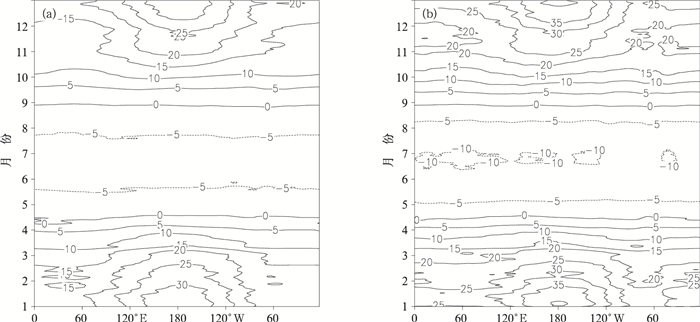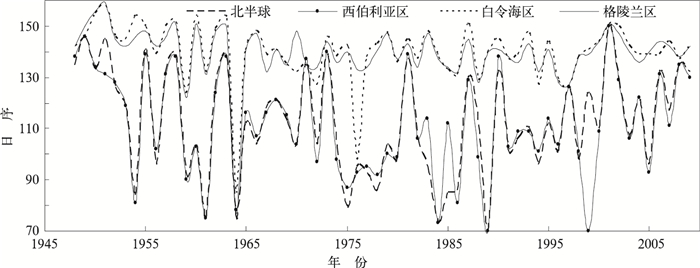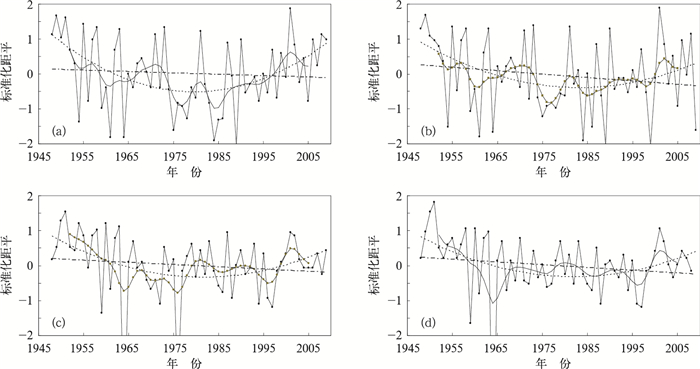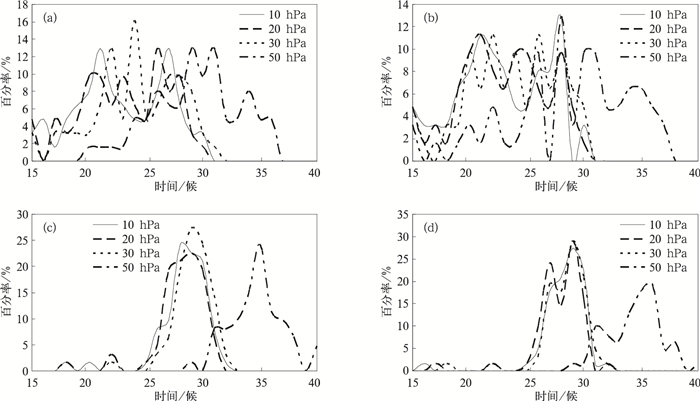The Basic Climatic Features of Stratospheric Circulation Transition in Northern Hemisphere
-
摘要: 利用1948—2009年NCEP/NCAR逐日高度场和风场再分析资料探讨了平流层各主要层次上环流转型的年际、年代际时空演变特征。结果表明:北半球平流层冬季环流转为夏季环流的过程是高层环流转型早,低层环流转型晚,但在各层次上环流转型早晚存在着区域性差异。自新地岛到西伯利亚北部地区的环流转型最早,且该区域与北半球环流平均转型时间的年际以及年代际特征最相近。北半球平流层环流转型的气候平均时间早于东亚热带季风爆发时间,从而可能成为季风预测的前兆信号。分析还得到平流层各主要层次环流转型时间具有明显的年代际特征,环流转型时间呈现由偏晚到偏早、又从偏早到偏晚的变化特征,只是年代际转折年份在不同区域、不同层次存在差异。此外,平流层环流转型时间普遍存在准2年、准3~6年、准9~12年以及准21~24年的周期,可能与气候系统其他成员有密切联系。Abstract: The basic climatic features of stratospheric circulation in Northern Hemisphere demonstrate different forms in winter and summer. In winter, the cold cyclone system and westerly winds prevail in high latitudes, while in summer the situation is the opposite. In terms of inversion of geopotential height gradient and zonal wind direction, a transition date index (TDI) indicating the change dates from summer to winter circulations in the stratosphere in Northern Hemisphere is defined by using NCEP/NCAR reanalysis daily data. Some statistic methods such as linear tendency, wavelet analysis, binomial coefficient smooth and Mann-Kendall are applied to analyze the inter-annual and inter-decadal features of the transition dates at all main levels in the stratosphere. Results indicate that in the stratosphere, with the height rising, the transition date becomes earlier and the summer circulation lasts longer. For instance, the earliest circulation transition in the stratosphere occurs at the height of 10 hPa and 20 hPa, and it shifts to 30 hPa in a short period. However, it takes longer for the transition to shift from 30 hPa to 50 hPa than that from 10 hPa to 30 hPa, which takes almost one month. The average onset date of the South China Sea Summer Monsoon (SCSSM) is one of the earliest dates in Asia Summer Monsoon (ASM) system and it is much later than the transition dates in stratosphere. Therefore, TDI can be used as a pre-signal for monitoring and predicting ASM. Furthermore, there exists an obvious regional difference in the circulation transition, among which the transition dates at each level in Siberia is the earliest and that is relatively later in Bering Sea and Greenland. The inter-annual and inter-decadal features of the circulation transition dates in Northern Hemisphere and the aforementioned three different regions are quite apparent, turning from late to early and then to late again in the past 62 years. Particularly the circulation transition date in Northern Hemisphere and in Siberia shares some similarities in inter-annual and inter-decadal variations, for example, the time variation shows significant fluctuations, and both have a transition peak in 1975. The transition dates in Bering Sea and Greenland also have the similar features, for example, the time fluctuation is relatively small. Moreover, circulation transition dates vary with the height and region, but they all have a quasi-2-year, a quasi-3-to-6-year, a quasi-9-to-12-year or a quasi-21-to-24-year cycle which may have close connections with other members of the climate system.
-
图 5 不同区域10 hPa环流转型时间的标准化距平 (带标记的实折线)、线性趋势 (点划线)、二阶多项式回归趋势 (虚线)、高斯九点平滑 (实折线)
(a) 北半球,(b) 西伯利亚区,(c) 白令海区,(d) 格陵兰区
Fig. 5 Standard deviation of annual transition dates at 10 hPa geopotential height of all regions (labeled solid line), the corresponding to linear trend (chain dotted line), second order polynomial regression line (dotted line), Gaussian 9-year running averages (solid line)
(a) North Hemisphere, (b) Siberia, (c) Bering Sea, (d) Greenland
表 1 北半球平流层环流转型时间
Table 1 Transition date of stratospheric circulation in Northern Hemisphere
高度/hPa 冬季环流转为
夏季环流时间夏季环流转为
冬季环流时间10 4月上中旬 8月底 20 4月上中旬 8月底 30 4月下旬 8月中下旬 50 5月上旬 8月初 表 2 不同区域、不同层次的平均环流转型时间
Table 2 Average transition dates at all levels of the regions
高度/hPa 北半球 西伯利亚区 白令海区 格陵兰区 10 第112天 第111.7天 第139.9天 第139.6天 20 第113.5天 第112.7天 第138.7天 第137.9天 30 第118.3天 第116.6天 第143.4天 第140.5天 50 第145天 第141.4天 第173.6天 第154.4天 表 3 北半球不同层次的最早、最晚转型时间
Table 3 Extreme transition dates at all levels in Northern Hemisphere
高度/hPa 最早转型时间 最晚转型时间 10 第70天 第150天 20 第70天 第151.5天 30 第70天 第155天 50 第96天 第181天 -
[1] 艾 [2] Baldwin M P, Dunkerton T J. Stratospheric harbingers of anomalous weather regimes. Science, 2001, 294:581-584. doi: 10.1126/science.1063315 [3] Baldwin M P, Cheng X H, Dunkerton T J. Observed correlations between winter-mean troposphere and stratospheric circulation anomalies. Geophys Res Lett, 1994, 21(12):1141-1144. doi: 10.1029/94GL01010 [4] 陈文, 魏科.大气准定常行星波异常传播及其在平流层影响东亚冬季气候中的作用.地球科学进展, 2009, 24(3):272-285. http://www.cnki.com.cn/Article/CJFDTOTAL-DXJZ200903007.htm [5] 廖荃荪, 王永光.赤道平流层QBO与我国7月雨型的关联.应用气象学报, 1998, 9(1):104-108. http://qikan.camscma.cn/jams/ch/reader/view_abstract.aspx?file_no=19980114&flag=1 [6] 陈兴芳, 艾 [7] 李崇银, 李琳, 谭言科, 等.平流层气候.北京:气象出版社, 2008:43-67. [8] 瞿章, 陈芳, 张海俊, 等.北半球50 hPa多年月平均经向剖面上的季节变化.高原气象, 1989, 8(4):345-350. http://www.cnki.com.cn/Article/CJFDTOTAL-GYQX198904005.htm [9] 瞿章, 张海俊, 贺慧霞.北半球50 hPa平均环流的若干特征及其与500 hPa的某些关联.高原气象, 1990, 9(4):424-431. http://www.cnki.com.cn/Article/CJFDTOTAL-GYQX199004010.htm [10] 葛玲, 郭树军.北半球30 hPa环流春季转变过程的诊断研究.应用气象学报, 1992, 3(3):306-313. http://qikan.camscma.cn/jams/ch/reader/view_abstract.aspx?file_no=19920351&flag=1 [11] 田荣湘, 高由禧, 瞿章. 1979年平流层大气环流季节变化的研究.高原气象, 1992, 11(2):170-177. http://www.cnki.com.cn/Article/CJFDTOTAL-GYQX199202007.htm [12] 刘晓东, 瞿章.北半球平流层环流与亚洲夏季风的关系的初步分析.气象学报, 1991, 49(2):244-248. doi: 10.11676/qxxb1991.034 [13] 陶诗言, 朱福康.夏季亚洲南部100毫巴流型的变化及其与西太平洋副热带高压进退的关系.气象学报, 1964, 34(4):385-396. http://www.cnki.com.cn/Article/CJFDTOTAL-QXXB196404000.htm [14] 李崇银, 顾薇, 潘静.梅雨与北极涛动及平流层环流异常的关联.地球物理学报, 2008, 51(6):1632-1641. http://www.cnki.com.cn/Article/CJFDTOTAL-DQWX200806003.htm [15] Kalnay E, Kanamitsu M, Kistler R, et al. The NCEP/NCAR 40-year reanalysis project. Bull Amer Meteor Soc, 1996, 77: 437-471. doi: 10.1175/1520-0477(1996)077<0437:TNYRP>2.0.CO;2 [16] 魏凤英.现代气候统计诊断与预测技术.北京:气象出版社, 2007:99-104. [17] 魏凤英.气候统计诊断与预测方法研究进展——纪念中国气象科学研究院成立50周年.应用气象学报, 2007, 17(6):736-742. http://qikan.camscma.cn/jams/ch/reader/view_abstract.aspx?file_no=200606122&flag=1 [18] 钱永甫, 江静, 张艳, 等.亚洲热带夏季风的首发地区和机理研究.气象学报, 2004, 62(2):129-139. doi: 10.11676/qxxb2004.015 [19] 柳艳菊, 丁一汇.南海季风爆发前后大气层结和混合层的演变特征.气象与环境研究, 2000, 5(4):459-468. http://www.cnki.com.cn/Article/CJFDTOTAL-QHYH200004010.htm [20] 王启祎, 丁一汇, 江滢.亚洲季风活动及其与中国大陆降水关系.应用气象学报, 1998, 9(1):83-89. http://kns.cnki.net/KCMS/detail/detail.aspx?filename=yyqx8s1.010&dbname=CJFD&dbcode=CJFQ [21] James R H, Tan H C. The influence of the equatorial Quasi-Biennial oscillation on the global circulation at 50 mb. J Atmos Sci, 1980, 37:2200-2208. doi: 10.1175/1520-0469(1980)037<2200:TIOTEQ>2.0.CO;2 [22] 李双林.热带印度洋增暖对南极平流层极涡的影响.中国科学 (D辑), 2009, 39(6):813-822. http://www.cnki.com.cn/Article/CJFDTOTAL-JDXK200906012.htm [23] Baldwin M P, Dunkerton T J. Observations and statistical simulations of a proposed solar cycle/QBO/weather relationship. Geophys Res Lett, 1989, 16(8):863-866. doi: 10.1029/GL016i008p00863 [24] 胡永云, 丁峰, 夏炎.全球变化条件下的平流层大气长期变化趋势.地球科学进展, 2009, 24(3):242-251. http://www.cnki.com.cn/Article/CJFDTOTAL-DXJZ200903003.htm [25] 郑彬, 施春华.全球平流层下部降温及其对纬向风的影响.气象科技, 2006, 34(5):538-541. http://www.cnki.com.cn/Article/CJFDTOTAL-QXKJ200605005.htm [26] 魏科, 陈文, 黄荣辉.北半球平流层极涡崩溃过程的动力诊断分析.中国科学 (D辑), 2007, 37(8):1110-1119. http://www.cnki.com.cn/Article/CJFDTOTAL-JDXK200708015.htm [27] 朱乾根, 郭品文.北半球春季大气臭氧变化特征及其对大气温度和环流场的影响.应用气象学报, 2001, 11(1): 448-454. http://qikan.camscma.cn/jams/ch/reader/view_abstract.aspx?file_no=20000466&flag=1 [28] 陈文, 杨蕾, 黄荣辉, 等.热带准两年振荡影响北半球冬季大气环流的诊断分析.大气科学, 2004, 28(2):161-173. http://www.cnki.com.cn/Article/CJFDTOTAL-DQXK200402000.htm [29] Black R X, McDaniel B A, Robinson W A. Stratosphere-troposphere coupling during spring onset. J Climate, 2006, 19:4891-4901. doi: 10.1175/JCLI3907.1 [30] Black R X, McDaniel B A. Interannual variability in the southern hemisphere circulation organized by stratospheric final warming events. J Atmos Sci, 2006, 64:2968-2974. doi: 10.1175/JAS3979.1 [31] Black R X, McDaniel B A. The dynamics of Northern Hemisphere stratospheric final warming events. J Atmos Sci, 2006, 64:2932-2946. doi: 10.1175/JAS3981.1 -


 设为首页
设为首页 加入收藏
加入收藏



 下载:
下载:







